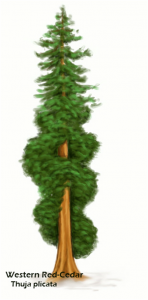 The Western Red-Cedar can stand to a graceful height of sixty to one hundred and thirty feet tall, but has been known to stand two hundred and seventy seven feet tall with a diameter of nearly fourteen feet.
The Western Red-Cedar can stand to a graceful height of sixty to one hundred and thirty feet tall, but has been known to stand two hundred and seventy seven feet tall with a diameter of nearly fourteen feet.
It can take over one thousand years to reach this size. The oldest confirmed Western Red-cedar was one thousand four hundred and sixty years old.
Despite the massive size of this tree, it has a delicate feminine appearance. The foliage is made of small scale-like leaves that spray out from thin arching twigs.
What was the Western Red-Cedar used for?
The large lower limbs become heavy and bend down toward the earth, then reach back up to gather the energy of the sun. It is not in appearance alone that this tree can be seen as a feminine tree; the indigenous tribes of the Pacific Northwest used the bark and wood to cloth themselves, make tools they used to hunt, and the boats to transport their goods.
It was also used to make totem poles that told the family histories and the history of their religions. One of the many common names for this tree is the Giant Arborvitae, which is Latin for tree of life.
Unique properties
To this day, modern cultures use this wood for its unique properties. In older trees, the Western Red Cedar produces a chemical called thujaplicin that is a natural fungicide, making it resistant to wet rot.
This creates a wood that is useful in outdoor locations like deck siding and roofing. It also has an aromatic property that makes it very pleasant for furniture or chest storage. If properly treated, it can retain its scent for up to a century.
Its first introduction to western civilization was through the Lewis and Clark expedition, where the explorers used the soft and light wood to make dugout canoes to travel by water as they approached the Pacific Ocean.

